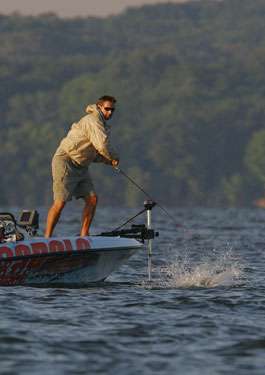
For millions of anglers around the country, fall means schooling bass. It's the season when voracious hordes of largemouth, smallmouth and spots push shad and other baitfish up against the surface and feed on them until they have to regurgitate.
It's the season when you can load the boat with aggressive bass in just a few well-timed and well-placed casts.
It can also be a time of great frustration on those occasions when vast schools of feeding bass seem to ignore every offering, no matter how many times you cast into the melee.
"Fall is a mirror to spring," says Elite Angler Bernie Schultz. "It's a great time to catch lots of shallow bass, including some big bass. In fact, I think fall is the second best big bass season of the year, behind only spring."
To maximize your chances of catching schoolers, you need to be in the right place at the right time. That usually means around long, tapering points or in the backs of creeks on reservoirs. On natural lakes, much of the schooling activity takes place around deep weedbeds.
Schultz looks for visual signs of schooling activity and acknowledges that it can range from surface explosions that look like concrete blocks falling from the sky down to surface dimples or visible pods of baitfish swimming near the surface.
"Early in the fall, the schooling activity usually occurs early and late in the day or on cloudy days. Later in the fall, the feeding will take place all day long," Schultz offers.
When he spots schooling activity, the first bait Schultz reaches for is a 1/2-ounce lipless crankbait like a Rat-L-Trap or Rattlin' Rapala.
"I like the 1/2-ounce models because I can cast them a long way," he says. "Sometimes the schoolers will pop up a long cast away, and the extra casting distance can mean a lot."
If the 1/2-ounce models don't generate bites, Schultz will scale down his offerings. He finds that the baits anglers throw that don't get bit are generally too large.
Other baits he likes for schoolers is the Rapala X-Rap Xtreme Action Slashbait in the XR08 and XR10 sizes and the Rapala Skitter Walk and Skitter Prop topwater lures. He'll even throw the Skitter Pop if the Walk and Prop don't work.
"I've caught schoolers all over the country — from Florida to Texas to New York — fishing these baits," he says. "They really work."
For most of his school fishing, Schultz uses a 6 1/2-foot medium-heavy Shimano baitcasting rod with a Shimano Calais reel spooled with Yo-Zuri Hybrid line in 12- to 17-pound-test for the lipless crankbaits and topwaters and 10- to 12-pound-test for the jerkbaits.
Schultz's tips should help you catch more schooling bass when they're up and actively feeding. Check out Part 2 of this series for ideas on how to catch them when they're not so active.




